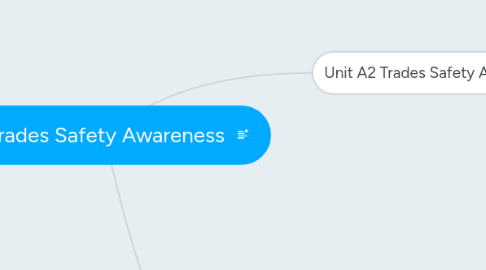
1. Unit A2 Trades Safety Awareness
1.1. 1. Identify safety and health requirements
1.1.1. Overview of the Workplace Safety and Health Act
1.1.1.1. Rights and responsibilities of employees under the Act
1.1.1.2. Rights and responsibilities of employers under the Act
1.1.1.3. Rights and responsibilities of supervisors under the Act
1.1.1.4. The law in Manitoba
1.1.2. 14 Regulations
1.1.3. Codes of practice
1.1.3.1. Construction Safety Association of Manitoba
1.1.4. Guidelines
1.1.4.1. Handout Posters
1.1.5. Right to refuse
1.1.5.1. explanation of right to refuse
1.1.5.2. Rights and responsibilities of employees under the Act
1.1.5.3. Rights and responsibilities of employerss under the Act
1.1.5.4. Rights and responsibilities of supervisors under the Act
1.2. 2. Identify Personal Protective Equipment (PPE) and procedures
1.2.1. Employer and employee responsibilities respecting PPE
1.2.2. Standards
1.2.2.1. ANSI
1.2.2.2. CSA
1.2.3. Work protective clothing and danger if it fits poorly
1.2.4. Gloves – Importance of proper glove selection (when handling chemicals, cold items, slivers, etc.)
1.2.5. Headwear – appropriate protective headwear when required and the approved type of headwear.
1.2.6. Eye protection – comparison and distinction of everyday eyeglasses, industrial safety glasses and safety goggles
1.2.7. Foot protection – when required according to safety standards
1.2.8. Hearing protection
1.2.8.1. Hazards of various noise levels (hearing protection must be worn)
1.2.8.2. Laws
1.2.8.3. types of hearing protection
1.2.9. Respiratory protection – types, overview of proper selection
1.2.10. Fall protection – Manitoba requirements standards guidelines ANSI (U.S.A. standards), etc.
1.2.11. Ladders and scaffolding
1.2.12. Safety principles for working with or around industrial trucks site-specific (forklifts, pallet trucks, etc.)
1.3. 3. Identify regulations pertinent to care and cleanliness in the working area.
1.3.1. Classes of Hazards
1.3.1.1. Safety
1.3.1.1.1. Housekeeping
1.3.1.1.2. Confined spaces
1.3.1.1.3. elevated work
1.3.1.1.4. electrical
1.3.1.2. Biological
1.3.1.3. Physical
1.3.1.3.1. temperature
1.3.1.3.2. noise
1.3.1.3.3. exposure to radiation
1.3.1.4. Ergonomic
1.3.1.4.1. Lifting
1.3.1.4.2. posture
1.3.1.4.3. repetitive
1.3.1.4.4. vibration
1.3.1.5. Chemical
1.3.1.6. Work organization
1.3.1.6.1. Respectful workplace
1.3.1.6.2. Over worked
1.4. 4. Identify the regulations relevant to the safe use of chemicals.
1.5. 5.Identify regulations governing the use of scaffolding.
1.6. 6. Identify regulations governing the use of ladders and related equipment.
1.6.1. Job-built ladders
1.7. 8. Hazard recognition and control.
1.7.1. Safe work practices
1.7.1.1. Basic risk assessment
1.7.1.2. Injury prevention and control measures
1.7.1.3. Identification of hazards involved in pneumatic tool use and explanation of how to guard against them
1.7.1.4. High pressure fluids
1.7.1.4.1. Refrigerants
1.7.2. SAFE
1.7.2.1. Spot the Hazard
1.7.2.1.1. 7. Ergonomics.
1.7.2.1.2. 9. Hazard of confined space entry
1.7.2.1.3. Biological
1.7.2.2. Assess the Risk
1.7.2.3. Find a Safer Way
1.7.2.4. Everyday
1.8. 10. First Aid/CPR
1.8.1. Overview of first aid regulation
1.8.2. Obligations of employers regarding first aid
1.8.2.1. Who is certified to provide first aid?
1.8.2.2. What to do while waiting for help?
1.8.2.3. Where is first aid kit?
1.8.3. Describe basic first aid requirements and techniques
1.8.3.1. Scope and limits of first aid intervention
1.8.3.2. Specific interventions (cuts, burns, abrasions, fractures, suffocation, shock, electrical shock, etc.)
1.8.3.3. Interface with other services and agencies (e.g., Workers Compensation claims)
1.8.4. Describe basic CPR requirements and techniques
1.8.4.1. How do you get certified?
1.8.4.2. Scope and limits of CPR intervention (include varieties of CPR certification)
1.9. 11. Identify the safety requirements as they apply to WHMIS with emphasis on
1.9.1. WHMIS is a system
1.9.2. Provincial regulation under the Safety and Health Act
1.9.2.1. Each province has a WHMIS regulation
1.9.2.1.1. Manitoba
1.9.3. Federal Hazardous Products Act
1.9.4. WHMIS generic training:
1.9.4.1. WHMIS defined and the format used to convey information about hazardous materials in the workplace
1.9.4.2. Information found on supplier and workplace labelling using WHMIS
1.9.4.3. Hazardous materials in accordance with WHMIS
1.9.4.4. Compliance with government safety standards and regulations
1.9.5. Description of WHMIS (include varieties of WHMIS Certification)
1.9.5.1. Typology of WHMIS labels, symbols, and classifications
1.9.5.2. Scope and use of Materials Safety Data Sheets (MSDS)
1.9.5.2.1. ABS Solvent Cement
1.9.5.2.2. Nu Clear Water Soluble Threading Oil
1.9.5.2.3. Master's Solder Paste
1.10. 12. Identifying and controlling hazards.
1.10.1. Basic control measures (injury prevention)
1.10.2. Safe work procedures
1.10.3. Explanation on the importance of industrial housekeeping
1.10.4. Employer responsibilities
1.10.5. How and where to store materials
1.10.6. Safety measures related to walkways, stairs and floor openings
1.10.7. Explanation of how to protect the worker and others when working in traffic paths
1.11. 13. Describe the safe storage of stock equipment in service vehicles.
1.12. 14. Discuss transportation of dangerous goods.
2. Assessment
2.1. Pre-test
2.1.1. Alberta Occupational Health and Safety Quizzes
2.2. Post- test
2.2.1. Written
2.2.2. Practical
